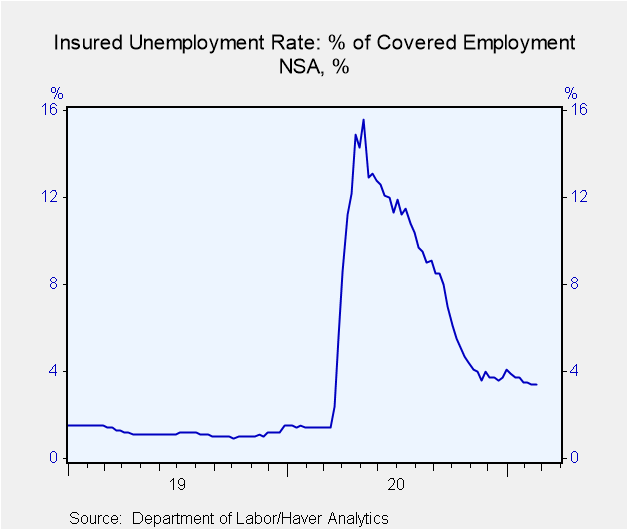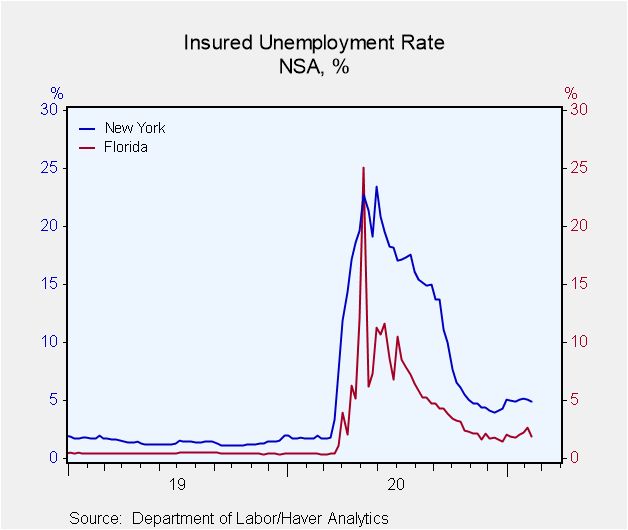 Global| Mar 04 2021
Global| Mar 04 2021U.S. Initial Unemployment Insurance Claims Rise Just 9,000
Summary
• PUA claims extend slightly higher range. • Continuing claims again extend their downward trend. • Insured jobless rate decreases for a sixth week. Initial claims for unemployment insurance rose modestly by 9,000 to 745,000 in the [...]
• PUA claims extend slightly higher range.
• Continuing claims again extend their downward trend.
• Insured jobless rate decreases for a sixth week.
Initial claims for unemployment insurance rose modestly by 9,000 to 745,000 in the week ended February 27; the prior week's 730,000 was revised to 736,000. The four-week moving average of initial claims eased further to 790,750, again the lowest since early December. The Action Economics Forecast Survey expected 790,000 initial claims for the latest week.
Initial claims for the federal Pandemic Unemployment Assistance (PUA) program were 436,696 in the February 27 week, an increase of 9,246 from the week before. These claims thus extended a recent slightly higher range that started in early December. The PUA program covers individuals such as the self-employed who are not included in regular state unemployment insurance. Given the brief history of this program, which started April 4, 2020, these and other COVID-related series are not seasonally adjusted.
Continuing claims for regular state unemployment insurance fell by 124,000 to 4.295 million in the week ended February 20 from 4.419 million during the prior week, which was unrevised. Continuing PUA claims for the week of February 13 eased to 7.328 million from 7.520 million in the prior week. The number of Pandemic Emergency Unemployment Compensation (PEUC) claims also decreased, in that week, reaching down to 4.467 million from 5.068 million the week before; that earlier week had the largest number of claims for this program. It covers people who were unemployed before COVID but exhausted their state benefits and are now eligible to receive benefits through March 14, 2021.
The total number of all state, federal and PUA and PEUC continuing claims was 18.027 million in the February 13 week, down by 1.019 million from the February 6 week. This grand total is not seasonally adjusted.
The seasonally adjusted state insured rate of unemployment edged lower yet again in the week ended February 13, a sixth consecutive decrease of 0.1%, reaching 3.0%. It was the lowest level since March 21, 2020, just as the pandemic was starting to impact labor markets.
The state insured rates of unemployment continued to show wide variation. In the week ended February 13, the lowest rates were in Alabama (0.88%), Utah (1.09%), South Dakota (1.34%), North Carolina (1.53%) and Tennessee (1.54%). The highest rates were in Connecticut (4.89%), Rhode Island (5.10%), Nevada (5.40%), Arkansas (5.70%) and Pennsylvania (6.33%). These state rates are not seasonally adjusted.
As we continue to point out, the Labor Department changed its seasonal adjustment methodology back in August from multiplicative to additive. They did not restate the earlier data, so there is a break in the series in late August. Though the current comparison to early September is valid, comparisons with figures before August 22 are not. Haver Analytics has calculated methodologically consistent seasonally adjusted claims series dating back to 1979. This series matches the Department of Labor seasonally adjusted series since their change in methodology. For more details, please see the September 3 commentary on jobless claims.
Data on weekly unemployment claims going back to 1967 are contained in Haver's WEEKLY database, and they are summarized monthly in USECON. Data for individual states are in REGIONW. The expectations figure is from the Action Economics Forecast Survey, carried in the AS1REPNA database.
| Unemployment Insurance (SA, 000s) | 02/27/21 | 02/20/21 | 02/13/21 | Y/Y % | 2020 | 2019 | 2018 |
|---|---|---|---|---|---|---|---|
| Initial Claims | 745 | 736 | 834 | 243 | 1,450 | 218 | 221 |
| Initial Claims (NSA) | 748 | 717 | 835 | 245 | 1,367 | 218 | 221 |
| Initial Claims Pandemic Unemployment Assistance (NSA) | 437 | 427 | 513 | -- | -- | -- | -- |
| Continuing Claims | -- | 4,295 | 4,419 | 150 | 10,664 | 1,701 | 1,756 |
| Continuing Claims (NSA) | -- | 4,806 | 4,829 | 128 | 10,358 | 1,704 | 1,763 |
| Continuing Claims Pandemic Unemployment Assistance (NSA) | -- | -- | 7,328 | -- | -- | -- | -- |
| Insured Unemployment Rate (%) | -- | 3.0 | 3.1 |
1.2 |
7.3 | 1.2 | 1.2 |
Carol Stone, CBE
AuthorMore in Author Profile »Carol Stone, CBE came to Haver Analytics in 2003 following more than 35 years as a financial market economist at major Wall Street financial institutions, most especially Merrill Lynch and Nomura Securities. She has broad experience in analysis and forecasting of flow-of-funds accounts, the federal budget and Federal Reserve operations. At Nomura Securites, among other duties, she developed various indicator forecasting tools and edited a daily global publication produced in London and New York for readers in Tokyo. At Haver Analytics, Carol is a member of the Research Department, aiding database managers with research and documentation efforts, as well as posting commentary on select economic reports. In addition, she conducts Ways-of-the-World, a blog on economic issues for an Episcopal-Church-affiliated website, The Geranium Farm. During her career, Carol served as an officer of the Money Marketeers and the Downtown Economists Club. She has a PhD from NYU's Stern School of Business. She lives in Brooklyn, New York, and has a weekend home on Long Island.









